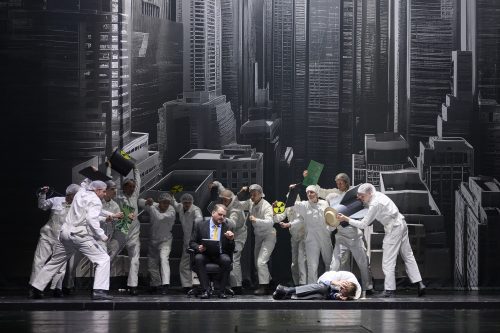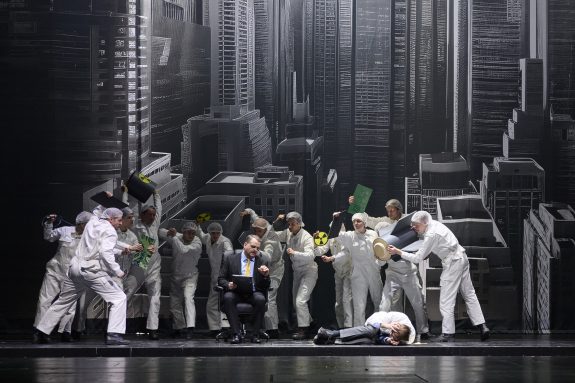 Germany Wagner, Das Rheingold: Soloists, Children’s chorus and Extras, Theater Dortmund; Dortmunder Philharmoniker / Gabriel Feltz (conductor). Dortmund Opera, 9.5.2024. (DMD)
Germany Wagner, Das Rheingold: Soloists, Children’s chorus and Extras, Theater Dortmund; Dortmunder Philharmoniker / Gabriel Feltz (conductor). Dortmund Opera, 9.5.2024. (DMD)

Production:
Director – Peter Konwitschny
Set and Costume design – Jens Kilian
Lighting design – Florian Franzen
Dramaturgy – Bettina Bartz, Daniel C. Schindler
Cast:
Wotan – Tommi Hakala
Alberich – Joachim Goltz
Loge – Matthias Wohlbrecht
Fricka – Ursula Hesse von den Steinen
Freia – Irina Simmes
Erda – Melissa Zgouridi
Donner – Morgan Moody
Froh – Sungho Kim
Mime – Fritz Steinbacher
Fasolt – Denis Velev
Fafner – Artyom Wasnetsov
Woglinde – Sooyeon Lee
Wellgunde – Tanja Christine Kuhn
Flosshilde – Marlene Gassner
79-year-old Peter Konwitschny has been a leading representative of director’s opera (Regieoper in German) for many years. With this production of Das Rheingold, he brought to a close his production of the Ring: He directed Götterdämmerung many years ago in Stuttgart (and will revive that production for Dortmund in 2025), as well as Die Walküre and Siegfried in Dortmund in 2022 and 2023, respectively. The production was highly entertaining overall – the story it told remained interesting and intriguing from beginning to end, so much so that it allowed us to overlook certain inconsistencies.
All the creatures populating the opera started off as those from primordial times, clad in fur, living in yurts or huts. Alberich was shown fishing in the Rhine with a primitive rod, his line dangling into the orchestra pit. The Rhinemaidens wore wigs of shimmering green hair. The closed red curtain was used to indicate the Rhine’s waves, a set of ladders suggested the different levels of the river’s depth, the Rhinegold was suggested by lighting and a large golden sheet of fabric on the stage floor, which was lifted up to the fly tower, together with Alberich, after he had renounced love.
When summoned by Fricka, Wotan came crawling out of his hut, yawning, stretching and scratching himself with a small bone. Later, when visitors were announced, he quickly exchanged the small bone for an enormous one – reference the spear! When the giants appeared, two sets of huge feet and shins appeared from the fly tower to suggest their size in relation to the gods.
Thanks to the Ring, Alberich the cave dweller became a top floor skyscraper city magnate, with Mime as lab assistant in a white coat. The gold became nuclear bombs, the magic Tarnhelm turned into a computer tablet. Erda was a fierce homeless woman who appeared with all her belongings in a trolley and a large number of children in tow. As she admonished Wotan to abandon the Gold and the Ring, she changed a baby’s diaper and disinfected another child’s injured knee.
While Donner cleared the air after Wotan had forfeited the Ring and Fafner had killed Fasolt, the gods transitioned from their primordial existence to become contemporary men and women, dressed in elegant, colourful attire, supported in this change by the Rhinemaidens, now turned nurses or carers – the changed gods soon became geriatric, Freia even passing away, in wheelchairs, in need of ear trumpets (Fricka) and asthma spray (Wotan).

This storytelling was very assured, tongue-in-cheek, and above all: robust. It was entertaining and did not allow much time to think about inconsistencies in the logic. The music supported and enhanced that strength. Together, the staging and the music reflected the atmosphere of Dortmund, the city’s architecture overall, and that of the opera house in particular. Gabriel Feltz provided as straightforward a reading of the score as Konwitschny did of the plot. This approach did not permit much by way of subtlety or finely chiselled nuances. Many of the long arcs of Wagner’s music, especially for Wotan, in his ‘Vollendet das ewige Werk’, ‘Zu mir, Freia’ and ‘Abendlich strahlt der Sonne Auge’ lost at least some of their beauty.
The cast obviously enjoyed the characters they were given to play, and their acting skills were considerable throughout. Sooyeon Lee, Tanja Christine Kuhn and Marlene Gassner were delightful as the Rhinemaidens, their voices crystal-clear at the beginning of the opera, and suitably subdued as they bewailed their paradise lost. Sungho Kim as Froh, Morgan Moody as Donner and Fritz Steinbacher as Mime made the most of their small parts. In Irina Simmes ringing soprano as Freia you could hear why she was highly praised for her recent Sieglinde. Melissa Zgouridi had a powerful voice as Erda, particularly in the lower register of her genuine alto. Artyom Wasnetsov sang Fafner with a very dark and black-sounding bass, while Denis Velev as Fasolt came across as more musical especially in the moments where he was allowed to show his genuine, if robust, feelings for Freia. Ursula Hesse von den Steinen was a feisty Fricka, although she had to struggle vocally against the orchestra at times. Joachim Goltz sang both carefree caveman and scheming businessman Alberich with a very melodious, strong and warm baritone. Matthias Wohlbrecht’s Loge was appropriately devious and scheming. His character tenor is certainly among the best of his generation. As Wotan, Tommi Hakala’s voice was sonorous, gentle with a strong core, and I would be keen to hear him with a different conductor.
The lighting design by Florian Franzen relied very impressively on copious amounts of stage fog – in fact the sound of the fog machines was sometimes louder than that of the orchestra. I assume the opera’s management are aware that stage fog or haze, no matter how it is generated, carries the risk of adverse effects on singers’ voices, and that therefore the opera’s management was prepared, on this occasion, to subject their singers to that risk.
Daniel Meyer-Dinkgräfe
